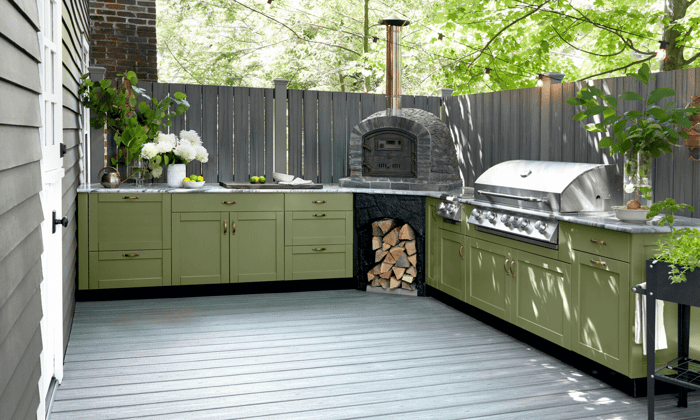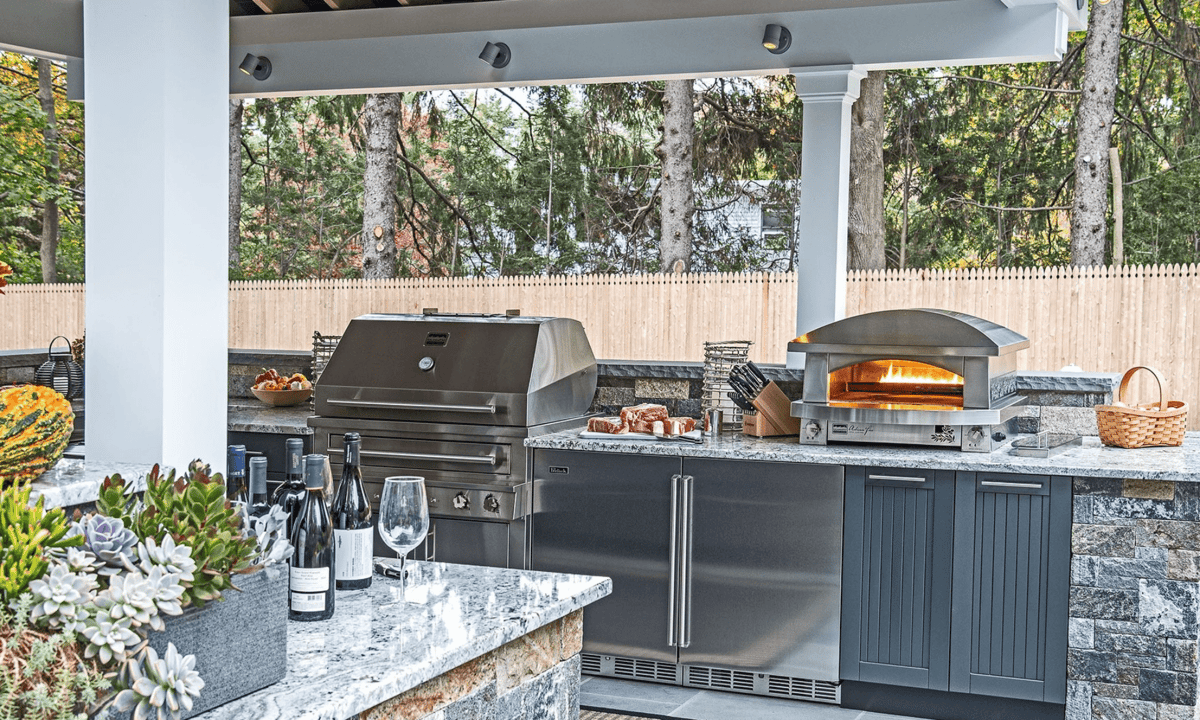Your Cart is Empty

There is a big demand for an Outdoor Pizza Oven in almost every kitchen we design. If you are like me perhaps you are wondering what is driving the demand? Why do people want an outdoor pizza oven?
We did some research and here is what we found. We will begin with the ‘pros’ of an outdoor pizza oven

Outdoor pizza ovens reach 700–900°F+, much hotter than a home oven.
This means you get:
Perfectly charred crusts
Melty cheese
Crisp, not soggy, bottoms
Done in 90 seconds or less (like in Naples!)
Roast vegetables, bake bread, sear steaks, make desserts—some ovens are like mini outdoor kitchens.
Wood-fired flavors can add taste and complexity you just can’t get indoors.
Guests love a pizza night where they can customize their own.
It’s a social, interactive cooking experience.
During summer, you don’t heat up your kitchen.
Especially useful if you live in a warm, tropical climate.
Your Air Conditioner and Pizza Oven will not be fighting each other
Wood, gas, or even charcoal—depending on the model, you can pick what suits your cooking style. There are hybrid models available which we will discuss below.
Cost: Can range from $300 (portable) to $3,000+ (built-in stone ovens).
Space: Needs outdoor space and a heat-safe surface. Does your outdoor kitchen cabinets require a heat jacket? Even with an outdoor counter top such as granite may not be enough.
Learning Curve: Wood-fired ovens in particular take some practice.
Maintenance: You’ll need to clean it and protect it from the elements.
Limited Use in Bad Weather: If it rains or snows a lot, you might use it less than expected.
Remember, some outdoor kitchen cabinets may require a heat jacket to protect the cabinets from heat. Check with the manufacturer of your outdoor pizza oven for a heat jacket.
Do you love cooking and trying new things?
Do you host people often and enjoy dining alfresco under the stars?
Do you have the outdoor space and budget?
Do you want to seriously upgrade your pizza game?
Do you enjoy being outside in the fresh air and find it relaxing?
If yes to most—an outdoor pizza oven could be totally worth it.
Both wood‑burning and gas‑powered pizza ovens have their strengths and trade‑offs. Which is “better” really depends on what you care about: flavor, convenience, cost, how often you’ll use it, how much effort you want to put in. I’ll go through the pros and cons of each, and then we can talk about which might suit you best.
Pros:
Flavor & character. Wood gives you that smoky, rustic flavor many people love. Different woods can impart different subtleties. Also, high radiant heat and flame dynamics help with charring, crisp crusts, etc.
Very high temperatures. Wood ovens can get extremely hot (often 800‑900°F or more), which is great for fast bakes (Neapolitan styles typically finish in ~60‑90 seconds).
Traditional / aesthetic appeal. The look, feel, ritual of building a fire, tending it, etc. Many people enjoy the process as much as the pizza.
Versatility. After the fire has died down you can use residual heat for baking bread, roasting, etc. Plus you can play with different kinds of wood, cooking surfaces
Cons:
Time to heat up. You need a long pre‑heat period (sometimes 30‑60 minutes or more) to get to optimal cooking temperature.
Skill required. Managing the fire (wood loading, airflow, heat zones, ash, etc.) takes practice. It’s less “set and forget” than gas.
Maintenance and fuel logistics. You need dry, good wood; storage; cleaning out ash; dealing with soot and smoke; more wear and weather exposure.
Less precise temperature control. Once it's hot, the heat is radiant and from burning wood, so controlling exact temperature is harder than with a burner; there can be hot spots or fluctuations.
Pros:
Convenience & speed. They heat up much more quickly; you can turn them on, get to cooking faster without building a large fire.
Temperature control & consistency. Easier to regulate the temperature, more consistent results from pie to pie. Less guesswork.
Less mess / less maintenance. No ash, less smoke, simpler cleanup, less fuel storage complexity.
Good for frequent use. If you expect to use it often—weekly or more—the convenience may mean you use it more, which could offset some downsides.
Cons:
Flavor limitations. You miss out on some of the smoky, charred flavor that wood provides. Some people say it’s a little “cleaner” but less “authentic.”
Often lower max temperatures. Gas ovens often don’t quite reach the peak temps a good wood‑oven can. That can affect the crust, char, speed
Ongoing fuel cost & dependency. Depending on local gas/propane rates, supply, etc., you’ll have recurring costs. Also, if gas supply is disrupted, you're stuck
To decide which is “better” for your situation, think about:
How often will you use it? If it’s just a few times a year, the ritual of wood may be fun. If it’s more frequent, gas may make it more practical.
How much effort do you want to put in? Do you enjoy tending fire, sourcing wood, managing temperature manually? Or do you prefer push‑button simplicity?
Flavor priorities. If you care a lot about smoky, charry flavor and authenticity (Neapolitan style, etc.), wood is hard to beat. If you just want good, reliable pizza with less fuss, gas does very well.
Space, weather, ventilation. Wood ovens produce smoke, need venting or being outdoors; gas ovens are cleaner but still need safe installation. If you’re in a windy place, or one with fire restrictions, wood may be more challenging.
Initial & running cost. Wood ovens can be pricey, especially good ones that retain heat well. But gas ovens cost too (burner, gas line or propane, etc.). Consider both up‑front and long term.
If I were choosing, for a typical homeowner who wants good pizza somewhat frequently without too much hassle, I’d probably lean toward gas or a hybrid (gas + wood). A hybrid option lets you get convenience when you want it and wood flavor/ambience when you’re in the mood.
But if you are all-in on authenticity, love the ritual, want the absolute classic Neapolitan crust, and don’t mind investing time/attention, then wood may be worth the extra work.
